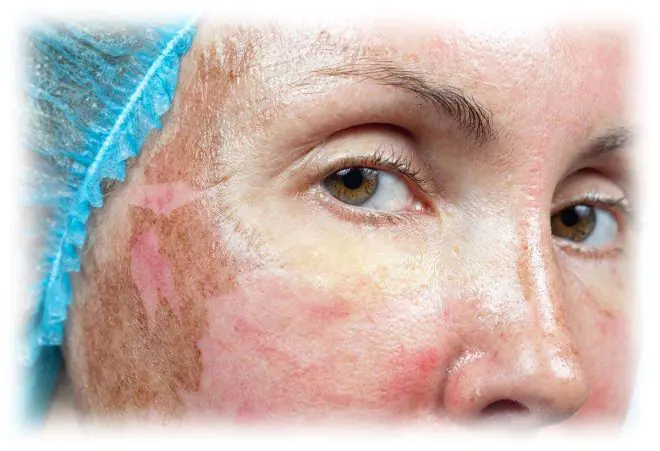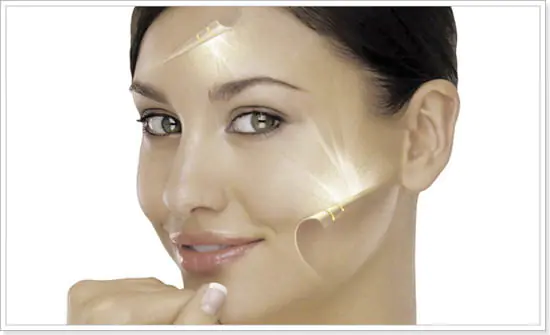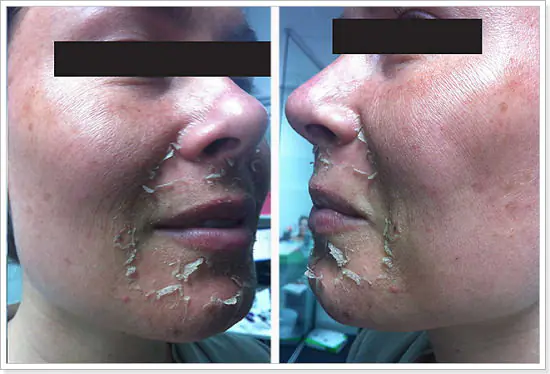After peeling with acids, many clients of beauty salons expect to instantly see soft, velvety skin, freshness and a healthy glow, but in return they receive a red face and active peeling of the skin. How to properly care for your face after a chemical peel to achieve the desired result as quickly as possible? What should and should not be done during a difficult recovery period for the skin?
What happens to the skin after peeling
Chemical peeling is a serious stressor for the skin. During the procedure, a concentrated chemical composition is applied to the face, which leads to extensive burns of soft tissue. The higher the concentration of the product used and the longer the time of its exposure to the skin, the stronger the burn and the more layers of the epidermis are damaged.
After peeling, the skin faces an important stage - recovery. Fibers damaged by chemical compounds die off, and new, resilient and elastic ones appear in their place. Outwardly, this does not look the most pleasant: the skin begins to actively peel off, peel off, as if you were sunburned. In addition, the face remains red and inflamed for some time.

In order for the post-peel rehabilitation process to proceed as smoothly as possible, without complications, cosmetologists recommend adhering to certain rules in skin care after chemical peeling and using special cosmetics. Only by fully complying with these requirements will you achieve maximum success and desired results.
Features of post-peeling care
After superficial cleansing
Superficial peels are considered the easiest for the skin; after them, the skin is quickly restored, and the risk of complications is minimal. Regular superficial cleansing can eliminate minor skin problems, prevent the appearance of wrinkles and other age-related imperfections.
Some procedures are used for medicinal purposes. For example, after salicylic peeling, problematic acne dries out, inflammatory processes inside the epidermis are reduced, which leads to a noticeable improvement in problematic skin type and a reduction in cases of acne in the future. But keep in mind that salicylic acid may not be suitable for those with dry and sensitive skin.
Before performing cleansing, be sure to consult a cosmetologist. His recommendations in choosing a procedure will allow you to correct existing imperfections on the face without worsening the situation.
Rehabilitation after superficial exfoliation lasts 7–10 days. Let's take a closer look at what processes happen to the skin after such peelings:
- The first 24 hours after the procedure, the face is red, later a feeling of tightness appears, as if cling film had been stuck to the skin. This is a normal reaction to acid exposure. On days 1–2, avoid contact with water.
- 2-3 days - active peeling of the skin appears. Starting from the second day, use wound-healing ointments (for example, Panthenol). It is necessary to apply the products 4-5 times a day to speed up the regeneration of the epidermis and alleviate its condition. Do not peel off loose films of skin; this can lead to wounds and, accordingly, there is a high risk of infection. As a rule, after such actions, scars remain that look unaesthetic. For washing, you can already use tonics and gels that do not contain abrasive particles.
- Active peeling after superficial cleansing lasts 3–4 days. At this time, cosmetologists advise using special hypoallergenic cosmetics, devoid of chemical additives and fragrances that could harm the weakened fibers of the epidermis.
- During the rehabilitation period, in addition to caring products, it is very important to use sunscreen cosmetics. Please note that the protective function of the skin after peelings is noticeably weakened, and the scorching rays of the sun can provoke skin pigmentation and even lead to burns.
Facial care after superficial and other types of cleansing includes a number of general recommendations that must be followed; we will talk about them later.
After medium peeling
Of the medium acid facial cleansings, exfoliation with trichloroacetic acid or TCA peeling is especially popular. The procedure for this procedure is identical to surface treatment with acid, the only difference being the concentration of the chemical ingredient. During medial cleansing, all layers of the epidermis up to the basement membrane are involved, without exception.

After TCA peeling, the facial texture is smoothed, average wrinkles and scars are corrected, and the skin regains lost elasticity and firmness.
The recovery period after a TCA peel can last up to several weeks. It is worth noting that there is a fairly high risk of complications if the cleansing technique is violated and if post-peeling care is improper. Therefore, performing TCA facial peeling at home can lead to unpleasant consequences.
Facial skin care after medium TCA peeling can be divided into several stages:
- 48 hours after exfoliation - contact with water is strictly prohibited. You can wash your face for the first time only for 2–3 days.
- During the procedure, fairly deep layers of skin are involved, so in most cases, mild swelling appears in sensitive areas of the face, the face is red and inflamed. If we talk about the normal course of rehabilitation after undergoing facial peeling, then these side effects will go away on their own. If you notice unusual changes in your skin, immediately contact a specialist for help.
- After a mid-TCA peel, you can only use special cosmetics recommended by a cosmetologist. Panthenol can be used to accelerate regeneration. You need to apply the product up to 8 times a day in a thick layer, and after 20 minutes, the remaining product can be soaked with a paper napkin. Often Panthenol stings - this is normal. After the procedure, the sensitivity of the integument increases, which leads to a similar reaction to the active effect of the drug.
- The first peeling on the face can be noticed a day after the procedure. The sagging skin cannot be peeled off, you can only carefully trim it with scissors. On average, the skin after TCA peels peels for 1–1.5 weeks.
- For six months after your last cleansing, apply sunscreen to your face even if it is raining or snowing outside, or if it is cloudy or gloomy.
Skin care after a mid-cleanse includes only high-quality cosmetic products, so be prepared to splurge on special cosmetics.
After deep cleaning
The main representative of deep chemical cleansing of the integument is phenolic peeling. This is a complex and responsible procedure that is carried out only in clinical, sterile conditions. During cleaning, the deep layers of skin up to the papillary layer are involved, which is why the procedure and recovery period are so painful.
Phenol is a dangerous substance, the improper use of which can even lead to death. Phenolic peeling is a lot of stress for the skin; it can be partially smoothed out by high-quality pre-peeling preparation and skin care after exfoliation.

Features in caring for skin after phenolic exposure include:
- You cannot wash your face for 2–4 days after the procedure; you even need to drink through a straw.
- Exfoliation with phenol is carried out only in adulthood. This is a one-time procedure, rehabilitation after which may take several months.
- The slightest mistake or violation during the procedure or in care after it will result in serious problems. Accordingly, approach the procedure as carefully as possible!
- In addition to special cosmetics, post-peeling care includes taking antiviral drugs and vitamins. This will strengthen the body, speed up recovery and restoration of the integument, and also prevent the occurrence of complications in the future.
- The skin will definitely darken after exfoliation with phenol - this is an acceptable reaction. The side effect will go away on its own and will not affect the result.
- Get ready for long-term use of special cosmetics, but put aside your usual facial care products.
- After the phenol peel, sunscreen is applied continuously.
If all recommendations are followed, your final result is minus 10–15 years. Whether you can take risks for such an effect is up to you, but it is important to note that the final result is comparable only to plastic surgery.
General recommendations from cosmetologists
In order to reduce the negative impact of external environmental factors, as well as not to delay the rehabilitation process, cosmetologists strongly recommend listening to their advice. First of all, they relate to the following points:
- You cannot wear makeup, use foundation or powder until the skin is completely restored after chemical peeling. Firstly, you can get an infection, and secondly, particles of decorative cosmetics and foundation will clog your pores and make your face look unkempt.
- Going to the sauna, steam bath, playing sports and performing increased physical activity after peeling is unacceptable and harmful. All these actions lead to an increase in temperature and abundant release of sweat particles, which are considered excellent carriers of infections. Plus, the expansion of blood vessels will delay the passage of facial redness. For the same reason, you will have to postpone fitness, drinking alcohol, hot and spicy foods.
- Do not wash your face in the first days after the procedure, even with plain water.
- Until the end of the rehabilitation period, use the range of products recommended by a specialist. Such products have a useful composition, a high moisturizing effect and do not irritate the skin.
- If you have the slightest suspicion of a deterioration in the condition of your facial skin after the peeling procedure, you need to go to a specialist. Self-medication is dangerous for the client’s health!
- Chemical cleanings are characterized by pronounced peeling of the integument. How many days this side effect lasts depends on the type of cleansing. However, in any case, it is forbidden to peel off the resulting film or crust. This will not speed up the recovery process, but will only lead to scars.
- Lotions, gels, and cream after peeling should not contain abrasive particles and acids, as they will damage the already burned fibers.
- Try not to touch the surface of your face with your hands, do not go to the pool until the integrity of the epidermis is completely restored, so that infection does not get inside.
Do not ignore the cosmetologist’s instructions; carefully study the rules of facial care after the procedure to reduce the risk of post-peeling complications and quickly enjoy smooth, clean and radiant skin. Only with such understanding will you achieve the perfection of covers without hassle or worry.
Many women who visit a cosmetologist's office are afraid that peeling will appear on the skin after peeling. For this reason, most of them simply avoid such a procedure. The number of fans of medium peeling increases every year. This procedure, when performed correctly, benefits the skin, improves its structure and color, helps restore tone, eliminates pigmentation and fine wrinkles on the face.
The procedure itself is characterized by the following process - an active acid (often fruit) penetrates deep into the epidermis and becomes an impetus for the natural regeneration of the skin. During the first time after the procedure, the skin may turn red, begin to peel, or even swell. The skin recovery time is about a week (in each case it is individual).
Features of peeling
If you decide to undergo such a procedure, you should first make sure that the cosmetologist who will do it is professional. Pay attention to the relevant documents and certificates, to the components used for peeling, and reviews on social networks play an important role. An important step is preparing the skin for a cosmetology session, and on the advice of a cosmetologist, special products for the skin are selected that prepare it for this type of procedure.

Today, medium chemical peeling using TCA acid in various concentrations and in various combinations with other agents has become a generally accepted procedure.
The next step that you should focus on is the time of year and climatic conditions, because medium peeling cannot be done in the summer and in intense sunlight. It is best to do it in late autumn or winter. If you live in conditions of increased solar activity, you will have to be patient and sit at home or indoors for a week (do not go to the beach and similar places), be sure to wear a wide-brimmed hat or a panama hat on your head, which will hide your face from annoying and dangerous people during such a period sun rays.
As for the type of peeling, it is selected individually for each person, depending on the characteristics of the skin. Regarding age, any cosmetic procedures are performed from the age of 18, with the exception of obvious indications (acne that needs to be treated, or acne scars), but parental consent is required. Superficial peeling is carried out in a course of 3 to 6 procedures, rest after each of them is at least a week. Medium peeling is done in a course of 1 to 3 procedures, the interval between them is at least 3 weeks. It is not recommended to take a course of any type of peeling more than once a year.
Typical and atypical consequences of peeling
Normal reactions to such actions on the skin are:

As a result of the removal of the protective upper layer of the epithelium, dehydration of this zone occurs, its sensitivity to ultraviolet and thermal radiation increases.
- Peeling of the skin after peeling is a natural reaction and you should not panic about this phenomenon. Individual skin characteristics and the type of medium peel will influence how long the skin will peel off. For example, after using trichloroacetic acid, not only peeling, but also swelling may appear. The average duration of this phenomenon is from 3 to 7 days.
- Redness. Medium peeling is basically a chemical burn, which will go away with proper skin care. It can be described as a thin film on the skin, which after a few days transforms into crusts. This process is similar to a sunburn. The intensity and duration of this reaction after cleaning is influenced by the depth of exposure to chemicals (acids) and the degree of damage. For example, after peeling using trichloroacetic acid and retinoic peeling, redness persists for 5 days. Sometimes the skin may not turn red at all, but may be pink or bright red. This reaction is most intense in the first minutes after the procedure, then gradually disappears.
- Swelling and pre-edema - appear on a thin layer of skin (neck, eyelids), such a reaction is normal for medium peeling.
Such consequences are normal and with proper skin care they are eliminated on their own. But you need to remember that if the redness and swelling intensify, then you should not hesitate, you should contact your cosmetologist and take the prescribed antihistamines.
Atypical consequences are: excessive rash, acne. This phenomenon occurs due to improper skin care after cleansing. To prevent this problem, apply anti-inflammatory and anti-acne products to your skin. In case of severe rash, you should visit a cosmetologist. His prescriptions usually include preparations containing zinc and antibacterial substances that help eliminate acne.
Another atypical consequence is scars and scabs. Under no circumstances should you rip off skin that is peeling off; you just need to moisturize it, constantly lubricating it with a rich cream. If the skin is peeled off, spots and unevenness may appear on the skin. With proper care, the crust will come off on its own.
Another consequence is hyperpigmentation. This reaction may be due to the wrong season for peeling. To avoid this phenomenon, it is necessary to remember that this procedure is inappropriate in the summer and spring. Before the procedure, you need to prepare the skin by treating it with kojic and retinolic acids.
Features of skin care after peeling
After superficial peeling, you can wash your face after a day, as you will feel tightness of the skin and a thin film will form on your face. After the mid-peel, you can wash your face no earlier than 2 days after your face has become covered with a thin shiny film and the skin has become tight. Washing can be done using thermal water and non-abrasive cosmetics. After any chemical cleansing, the skin should be treated with Panthenol or rich moisturizing creams. You should not be in the sun after the procedure or tan in a solarium for a month after cleaning.
You should remember to intensively moisturize the skin, so it will heal and recover faster. You should give preference to cosmetics that have a gel-like structure, so they will be absorbed in a matter of minutes and moisturize well, eliminating tightness and dryness of the skin.
But using any products in the first few days after cleansing is contraindicated; only when the skin begins to peel after cleansing can you intensively moisturize it.
You should protect your skin from the sun, wind, cold and other irritants. This way you can avoid hyperpigmentation. After peeling, focus on creams containing antioxidants. When going outside, apply products with a high level of sun protection (50) to your skin. This also applies to skin care in the autumn. Such products should be used 2 months after dry cleaning.
An important factor is the refusal of decorative cosmetics while the skin is recovering. No need to touch your face, do not use decorative cosmetics for several weeks. By following simple rules, you can ensure fast and most comfortable skin recovery after peeling.
Skin is peeling - what to do?
This process is normal after a cosmetic procedure. This is a sign that the procedure was performed correctly and the process of cell regeneration has already begun. There is no need to be afraid or panic at the sight of flaky skin. When the skin is exposed to aggressive substances, the top layer of the epidermis is practically removed through peeling. Dead cells are removed, new, young and healthy ones appear. In the case of superficial peeling, peeling is not pronounced and disappears a day after the procedure. After the mid-peel, the top layer of skin peels off, which begins a few days later and continues throughout the recovery period.

Uniform darkening of the skin, which goes away on its own after exfoliation (after 1-2 weeks).
There is no need to rip off pieces of what has peeled off. To speed up this process, you should follow the recommendations of cosmetologists and properly care for your skin. This will ensure uniform and painless exfoliation, after which there will be no scars or pigment spots. For skin care, use creams containing Panthenol, fatty creams, and thermal water for washing. All these products help improve the protective functions of the skin and give it the missing moisture for optimal cell regeneration. There is no need to be afraid to visit a cosmetologist's office. All consequences are individual and, if the procedure is carried out correctly, are minimal.
Peeling of tissues after peeling is a natural phenomenon for which every woman who decides to undergo the procedure is mentally prepared. If you do not first become familiar with the basic principles of the influence of chemical and mechanical actions on the dermis, the detachment of the top layer can cause disappointment.
All salons promise smooth, silky skin after the procedure. Ignorance in this matter leads to the fact that young ladies begin to eliminate or disguise the “side effect” in every possible way. Salon cosmetologists usually warn about what to expect and how to care for the injured surface. The client is also introduced to why it is impossible to rip off the skin after peeling and what the consequences are.
What happens to facial skin after peeling
The effects of acids, alkalis, and hardware procedures cannot pass without leaving a trace. Before starting the procedure, you need to have an idea of how the skin can react and what is considered normal or pathological.
Natural reaction to peeling:
- Peeling of the skin should not be a concern; it is a normal reaction. The duration of exfoliation of dead cells depends on the concentration of the compositions, the type of cleansing procedures, and the individual characteristics of the body. After using intensive reagents, swelling may additionally occur. It should be noted that the discomfort lasts from three days to a week and only after that you can feel all the benefits of peeling.
- Redness of the tissue accompanies the rehabilitation period after medium peeling. Since the effect of the procedure is manifested by signs of a burn, it is worth paying special attention to facial treatment and proper care. How long the regeneration process will continue depends on the depth of penetration of the chemical components and the degree of tissue damage. If a thin layer of skin peels off in a thin layer, do not panic, and do not tear off the skin during the exfoliation process. The degree of redness can vary from pale pink to intense red. In some cases, there is a complete lack of reaction. Skin recovery after peeling may take 5 days or more. Peak redness appears immediately after the manipulation, then. Every day the color becomes paler. It is worth emphasizing that if the patient has torn off the scab, rapid recovery processes should not be expected; moreover, the end result may be the opposite of what was expected.
- When performing medium peeling in the area of the eyelids and neck, you should expect swelling and swelling, since very delicate tissues are exposed and the result is quite predictable.
All of the above signs are considered normal skin reactions. A cosmetologist should warn about such symptoms. Proper care and careful treatment of sensitive tissue after the procedure are shown; exfoliated keratinized cells are eliminated, leaving behind a healthy shine, even tone, smoothed wrinkles.
Persistent redness with swelling is a reason to consult a doctor. Individual immunity and allergies require the intervention of an allergist and the use of antihistamines.
Anomalous consequences that are not typical:
- Intense rashes.
- Water bubbles.
- Pimples.
- Scars, scabs.
- Hyperpigmentation.
Such phenomena are explained by improper facial skin care after the procedure. In such cases, the use of anti-inflammatory drugs and anti-acne agents is indicated. Therapy by a cosmetologist uses zinc and antibacterial drugs.
No matter how aesthetically pleasing peeling skin may look, tearing it off is strictly prohibited. Such areas of the face should be moisturized and lubricated with rich creams. Violation of the rule reduces the procedure to the category of useless, since pigment spots and lumpiness appear in the places where the scales are removed. The tone of the face becomes more painful than before the procedure.
Pigment spots on the face can not only disappear after the procedure, they also tend to appear due to peeling during the aggressive period of the sun, in the absence of protection from sunlight, and insufficient hydration. Pigmentation can be prevented by preparatory manipulations using kojic and retinolic acids.
The most important mistakes in post-peeling care
An important link influencing the regeneration processes is preparation. Without correctly determining the skin type, the intensity of penetration of acids or the depth of action of hardware procedures, it is difficult to say how the recovery will proceed. Dermatological features also influence the result. In addition, women make a number of mistakes that nullify the procedure. It is forbidden:
- Peel off the skin after peeling.
- Use gels, foams, and soaps for washing.
- Stay outside for a long period of time under the influence of the sun's rays.
- Apply physical pressure with brushes to the injured skin of the face.
- Use masks, creams, serums.
- Visit baths, steam rooms, and the gym.
- Sunbathe.
- Do not use protective creams 35 SPF or higher.
- Allow aggressive action on the skin.
- Apply cosmetics (even decorative ones).
It is recommended to carry out the facial cleansing procedure during the weekend or while on vacation. Layers of exfoliation on the face do not look very aesthetically pleasing, and the cosmetologist’s instructions on why you should not peel off the skin during the healing process sound more than convincing.
Other mistakes after peeling are presented in the video:
Is it possible to rip off the skin after peeling?
The question of why you can’t tear off the skin after peeling should be answered competently and competently by a cosmetologist. All possible reactions must be described before starting the manipulation. A woman should be mentally prepared for such metamorphoses and, if necessary, take an extra day off to retire at home.
Recommendations from cosmetologists
For the recovery process to go smoothly, it is necessary to eliminate all possible risks of negative consequences. Cosmetologists advise:
- Before making an appointment with a cosmetologist, find out, based on customer reviews, about his professional reputation.
- Review the documents confirming the right to work.
- The first procedure is best performed by a professional technician. This will allow you to have an idea in the future about the correctness of the sensations and all the regeneration processes that occur after the procedure, but are not pathology.
- Do an allergy test.
- Read the list of contraindications. If in doubt, discuss the issue with your doctor.
- Study the nuances. How much time is spent on preparation and rehabilitation?
- If the doctor forbade skin peeling, this is not her whim, and the advice should be taken.
- The specialist should tell the client in detail what to do if the skin is torn off and how to moisturize the face after manipulation. The woman’s task is to strictly follow the recommendations.
Conclusion
Peeling procedures are gaining popularity every day, and this is explained by the consistent positive results. Women always strive to be beautiful and well-groomed, to prolong their beauty and youth for many years. Sometimes even the recovery process leads to restrictions in the usual way of life. To avoid prolonged peeling and excessive dryness after the procedure, you must adhere to the advice of a cosmetologist and thoroughly follow the main rules of facial care.



